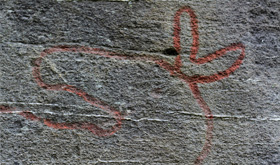Posted by Pål Ødegård on / 0 Comments
Five thousand years ago a man stands at the foot of the cliff. He holds a sharp stone in his hand. He has already sketched the silhuette of an elk on the rock. Now he begins the arduous task of carving the grooves deeper into the rock. He carves an image of a young elk in a striking pose, turning its head, looking towards a larger animal. The other carvings were perhaps made hundreds of years ago.
The artist and his people are hunters and gatherers. This is the stone age. Humans on all continents make carvings and paintings like this, called petroglyphs, for thousands of years. And up through the ages they remain on the rocks and cliffs bearing witness to the culture of or predecessors.
Maybe they carved the elks in the rock to give them power over the animals, and to ensure good hunting? Or maybe the figures were made by shamans who could take the shapes of animals and travel to the spirit world? Or maybe the petroglyphs were the backdrop for the stone age theatre, where stories were told around the campfire from one generation to the next?
We know little about the reasons why the carvings were made, and what they meant. They had no written language, so we have no testimonies from their world and their age. The only clues we have are the tools and artifacts that archeologists uncover, as well as the enigmatic petroglyphs.
Show the Rock Art at Stykket on a larger map.

